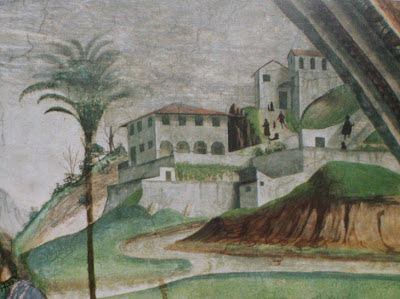Let us begin at the Palazzo Medici Riccardi (see post of Sun, Jan 29, 2012), at the corner of Via Cavour and Via de' Gori. The conspirators had originally set their sights on this palace to carry out their attack on the two Medici brothers, but as Guiliano was not in attendance, the site was changed to the duomo, one long block away, down Via de Martelli:
We'll walk around the north side of the cathedral, taking note of the fact that Lorenzo hid in the North Sacristry until it was safe to get back to the Palazzo Medici-Riccardi (see post of Feb 3, 2012 for more info on the duomo). We'll proceed to the street facing the east side of the cathedral, the Via del Proconsolo, and we'll turn south, going about a block to the corner where Borgo degli Albizi meets Via del Corso. This is the Canto dei Pazzi (see post of Nov 25, 2012), where the Pazzi and their compatriots would have run from the melee that ensued after the murder of Guilano and the attempt on the life of Lorenzo.
Looking up we can see the Pazzi coat of arms (see post of Sep 28, 2012), and on the ground level we can take note of the entrance to the Palazzo Pazzi Quaratesi. If we had been here Sep 21 & 22, 2012 and if we had purchased a 15 euro "wine card," as part of the Wine town 2012 festivities, we would have been able to enter (see <www.winetown.it> for details). Since we missed that opportunity, we'll continue south along Proconsolo another long block or so until we see the Bargello.
Today the Bargello is the National Sculpture Museum, but in the time of the Medici it was a prison, and it was in this place that many of the low-level conspirators were hanged. There will be more on the Bargello, one of my favorite museums, in a later post. From here we cross the tiny Piazzi di San Firenze, turning right at Via di Gondi, which is also the most northeast corner of the Palazzo Vecchio.
Walking around to the front of the Palazzo, we see the windows at the top which served as a continuous gallows during those three days after the attempted coup. The bodies of the major conspirators--Francisco de' Pazzi and the Archbishop of Pisa among them--were each left dangling by a noose above the crowd below (see post of Oct 20, 2012). In all, about a hundred people were killed in three days.
I don't know about you, but one of the things that impresses me most about Florence is its permanence. Living in Southern California as I do most of the year, I have become accustomed to public, commercial, and private buildings being continuously torn down and replaced. It gives me great reassurance to walk around Florence and see that the major landmarks are still there, as they were three, four, five hundred years ago.












































